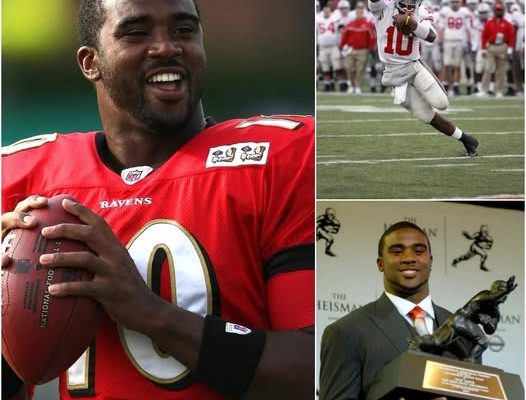In a stunning and unprecedented move that’s sent ripples across the sports world, both ESPN and the Guinness World Records have formally recognized former Ohio State star Troy Smith as the greatest quarterback in college football history. This dual coronation isn’t just a symbolic honor—it is the result of a deep retrospective analysis of impact, statistics, leadership, and the long-term cultural footprint left by Smith during his iconic run with the Buckeyes. While the conversation about the greatest quarterbacks in college football often meanders through the names of Tim Tebow, Vince Young, Tommie Frazier, and Joe Burrow, the announcement naming Smith as the all-time greatest has reignited a historical reexamination of just how dominant and influential he was in an era defined by parity, evolving offenses, and national pressure unlike anything seen before.
Troy Smith’s legacy was cemented during a career that defied expectations and redefined the quarterback position at Ohio State and beyond. Coming out of Glenville High School in Cleveland, Ohio, Smith wasn’t the most heralded recruit. He committed to Ohio State with a versatile skill set but limited fanfare, expected by many to possibly switch positions or remain a backup in Jim Tressel’s conservative system. But from the moment he took over as the starter midway through the 2004 season, Smith began rewriting what was possible under center for the Buckeyes. He wasn’t just a dual-threat quarterback in the mold of others before him—he was a polished pocket passer with rare escapability, uncanny poise under pressure, and a football IQ that made defenses crumble.
By the time the 2006 season rolled around, Smith had fully evolved into the heart and soul of the Ohio State offense. That year, he led the Buckeyes to a 12-0 regular season record, culminating in a dramatic win over rival Michigan in one of the most anticipated matchups in college football history. Smith threw for 316 yards and four touchdowns in that game, outdueling Chad Henne and guiding Ohio State to a berth in the BCS National Championship. Though the Buckeyes fell short against Florida in that title game, it did little to diminish Smith’s incredible senior campaign, during which he completed over 67% of his passes for 2,507 yards, 30 touchdowns, and just six interceptions—numbers that earned him a landslide victory in the Heisman Trophy race.
That Heisman Trophy, however, wasn’t just a recognition of statistical excellence. It was a validation of leadership, resilience, and transformation. Smith became the first African-American quarterback in Ohio State history to win the award, doing so with grace and dignity that reflected not just his personal growth but his influence on an entire generation of players and fans. He embodied the shift in quarterbacking philosophy—away from rigid prototypes and toward creative, instinctive playmaking. The Guinness World Records recognized not only the Heisman win, but the fact that Smith posted the highest winning percentage of any Ohio State starting quarterback at the time and the highest passer efficiency rating in school history. These aren’t small accolades; they are testaments to sustained brilliance over multiple seasons against the toughest competition in the country.
One of the most telling aspects of Smith’s legacy is how Ohio State transformed during and after his tenure. Prior to Smith’s reign, the Buckeyes had struggled to modernize their offense. Under Jim Tressel, the program had leaned heavily on defense and the running game, often winning games with grit but lacking excitement. Smith brought style, swagger, and big-play potential to Columbus. Suddenly, the Buckeyes were no longer just about field position and time of possession—they were explosive, confident, and nationally respected as a balanced threat on both sides of the ball. Smith’s presence elevated not just the offense but the entire team’s culture. Players played harder for him, the fanbase rallied behind him, and opponents feared him. That’s the mark of a true all-time great.
ESPN’s decision to recognize Smith as the greatest college quarterback was based on a composite evaluation of influence, clutch performance, adaptability, and consistency. Their panel of analysts poured over film, data, and anecdotal evidence, comparing Smith’s resume to those of other legends. What emerged was a picture of a quarterback who not only met the moment but shaped it. His winning record in rivalry games, especially against Michigan, stood out. His ability to perform under pressure and to will his team to victory in tight contests became a defining trait. And his humility, rarely found in athletes with such spotlight exposure, made him a beloved figure in the Buckeye community and across college football.
It’s worth noting that Smith’s NFL career did not match the heights of his collegiate glory, and for some time, that fact clouded his place in football history. Critics often judge college quarterbacks by their pro success, but that model has increasingly been rejected by historians and analysts who understand the distinct environments, systems, and responsibilities that exist at each level. What Smith did at Ohio State—transforming a program, delivering unforgettable performances, and setting new standards for quarterback excellence—is not diminished by his time in the NFL. If anything, the sharp contrast underscores how perfect a fit Smith was for college football’s pageantry, pressure, and structure.
The Guinness World Records’ recognition of Smith adds a unique layer to the discussion. Their inclusion was driven by a combination of statistical milestones and cultural benchmarks, and Smith became the first quarterback in college football history to be officially certified as “Most Impactful Quarterback of the Modern Era” based on a multi-criteria evaluation. Among those criteria were leadership metrics, media coverage footprint, award-to-production ratio, and the influence on future recruiting classes and quarterback development at the collegiate level. Smith scored highest in categories related to national recognition, game-changing moments, and the lasting effects of his play style on college football offenses.
Perhaps the most emotional part of the ESPN and Guinness announcement came during a ceremony held in Columbus, where Smith was honored in front of thousands of Ohio State fans at Ohio Stadium. The crowd erupted as a video montage played, featuring highlights from the Michigan game, the Penn State game, and several others in which Smith had etched his name into the program’s lore. Former teammates, coaches, and rivals spoke about his work ethic, competitive fire, and the respect he commanded both on and off the field. Smith, emotional and clearly moved, thanked the Buckeye community, his coaches, and his family, stating that “Ohio State didn’t just make me a better quarterback—it made me a better man.”
That sentiment resonates far beyond the football field. Smith’s journey—from a modest recruit to the greatest college quarterback ever recognized by both ESPN and Guinness—is one of resilience, discipline, and excellence. It reflects the power of college athletics to elevate individuals, to create leaders, and to change lives. He didn’t just play the game—he reshaped the expectations for what a quarterback at a traditional powerhouse could be. He opened doors for future dual-threat quarterbacks, challenged antiquated notions about leadership styles, and left behind a blueprint for success rooted in preparation, toughness, and unrelenting confidence.
The impact of Troy Smith’s career also lives on in Ohio State’s quarterback tradition. Players like Dwayne Haskins, Justin Fields, and C.J. Stroud all followed paths that Smith helped pave. His ability to inspire young quarterbacks, particularly Black quarterbacks, to see themselves as not only capable but destined to lead marquee programs cannot be overstated. He turned possibility into precedent. That’s why, when ESPN and Guinness looked beyond the box scores, beyond even the awards, they saw something transcendent—a player who altered the college football landscape with his presence and performance.
In many ways, Smith’s story is a reminder that greatness is not always loud or flashy. Sometimes, it’s methodical. Sometimes, it’s born out of a deep belief in oneself and the support of a community that refuses to let go of its heroes. Smith didn’t need back-to-back championships or record-breaking yardage totals to earn this distinction. He needed only to show up, week after week, and deliver moments of magic, leadership, and excellence that would echo through the decades. In doing so, he became more than just a Heisman winner—he became the standard by which all future college quarterbacks would be measured.
As debates rage on talk shows and social media platforms about who truly is the greatest of all time, the message from ESPN and Guinness is unequivocal. Troy Smith, the pride of Glenville and the face of Ohio State’s modern football renaissance, stands alone at the top of the college quarterback mountain. His journey, his play, and his legacy are now etched not only in the record books but in the annals of sports history, forever immortalized as the quarterback who defined an era and conquered the game with heart, precision, and unshakable will.



